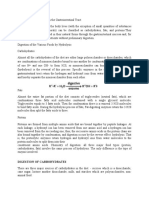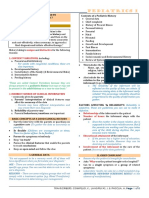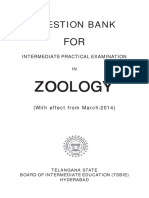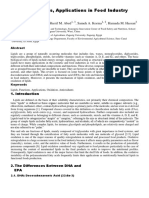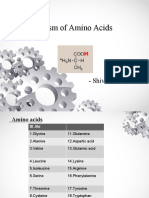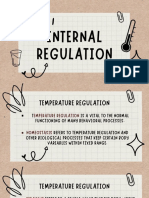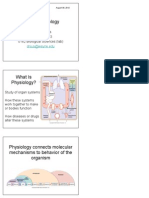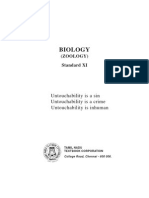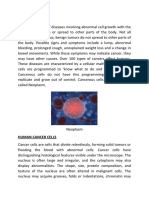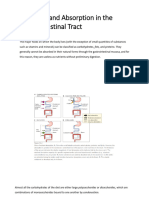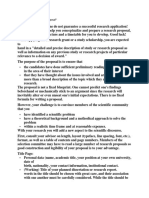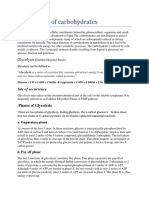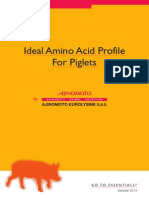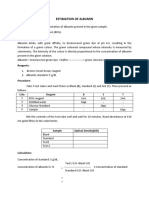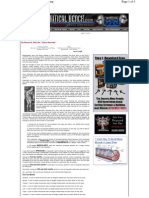0 ratings0% found this document useful (0 votes)
73 viewsDigestive System: Digestion and Absorption of Carbohydrates, Proteins and Fats
Digestive System: Digestion and Absorption of Carbohydrates, Proteins and Fats
Uploaded by
hiThe document summarizes the digestion and absorption of carbohydrates, proteins, and fats in the human digestive system. It describes how carbohydrates like starches and disaccharides are broken down by amylases in the mouth and small intestine into monosaccharides like glucose that are then absorbed. Proteins are partially broken down by pepsin in the stomach and further digested by pancreatic enzymes into dipeptides, tripeptides and amino acids in the small intestine. Fats are emulsified by bile and lecithin in the small intestine to allow lipases to break them into fatty acids and monoglycerides that are absorbed.
Copyright:
© All Rights Reserved
Available Formats
Download as PPTX, PDF, TXT or read online from Scribd
Digestive System: Digestion and Absorption of Carbohydrates, Proteins and Fats
Digestive System: Digestion and Absorption of Carbohydrates, Proteins and Fats
Uploaded by
hi0 ratings0% found this document useful (0 votes)
73 views45 pagesThe document summarizes the digestion and absorption of carbohydrates, proteins, and fats in the human digestive system. It describes how carbohydrates like starches and disaccharides are broken down by amylases in the mouth and small intestine into monosaccharides like glucose that are then absorbed. Proteins are partially broken down by pepsin in the stomach and further digested by pancreatic enzymes into dipeptides, tripeptides and amino acids in the small intestine. Fats are emulsified by bile and lecithin in the small intestine to allow lipases to break them into fatty acids and monoglycerides that are absorbed.
Original Description:
k
Original Title
3
Copyright
© © All Rights Reserved
Available Formats
PPTX, PDF, TXT or read online from Scribd
Share this document
Did you find this document useful?
Is this content inappropriate?
The document summarizes the digestion and absorption of carbohydrates, proteins, and fats in the human digestive system. It describes how carbohydrates like starches and disaccharides are broken down by amylases in the mouth and small intestine into monosaccharides like glucose that are then absorbed. Proteins are partially broken down by pepsin in the stomach and further digested by pancreatic enzymes into dipeptides, tripeptides and amino acids in the small intestine. Fats are emulsified by bile and lecithin in the small intestine to allow lipases to break them into fatty acids and monoglycerides that are absorbed.
Copyright:
© All Rights Reserved
Available Formats
Download as PPTX, PDF, TXT or read online from Scribd
Download as pptx, pdf, or txt
0 ratings0% found this document useful (0 votes)
73 views45 pagesDigestive System: Digestion and Absorption of Carbohydrates, Proteins and Fats
Digestive System: Digestion and Absorption of Carbohydrates, Proteins and Fats
Uploaded by
hiThe document summarizes the digestion and absorption of carbohydrates, proteins, and fats in the human digestive system. It describes how carbohydrates like starches and disaccharides are broken down by amylases in the mouth and small intestine into monosaccharides like glucose that are then absorbed. Proteins are partially broken down by pepsin in the stomach and further digested by pancreatic enzymes into dipeptides, tripeptides and amino acids in the small intestine. Fats are emulsified by bile and lecithin in the small intestine to allow lipases to break them into fatty acids and monoglycerides that are absorbed.
Copyright:
© All Rights Reserved
Available Formats
Download as PPTX, PDF, TXT or read online from Scribd
Download as pptx, pdf, or txt
You are on page 1of 45
DIGESTIVE
SYSTEM
Digestion and Absorption of
Carbohydrates, Proteins and
Fats
CARBOHYDRATE DIGESTION
CARBOHYDRATE FOODS OF
THE DIET
– Only three major sources of carbohydrates exist in the normal human diet.
– They are sucrose, which is the disaccharide known popularly as cane sugar;
– lactose, which is a disaccharide found in milk; and
– starches, which are large polysaccharides present in almost all non animal foods,
particularly in potatoes and different types of grains.
– Other carbohydrates ingested to a slight extent are amylose, glycogen, alcohol, lactic
acid, pyruvic acid, pectins, dextrins, and minor quantities of carbohydrate derivatives in
meats.
– The diet also contains a large amount of cellulose, which is a carbohydrate. However, no
enzymes capable of hydrolyzing cellulose are secreted in the human digestive tract.
Consequently, cellulose cannot be considered a food for humans.
Carbohydrate digestion
Polysaccharides hydrolyzed
by amylases (in saliva &
pancreatic juices) to
disaccharides
Sucrase, lactase, maltase
found in cell membrane of
villi cells hydrolyze into
monosaccharides, mostly
glucose
Hydrolysis of Carbohydrates
– Almost all the carbohydrates of the diet are either large polysaccharides or disaccharides,
which are combinations of monosaccharides bound to one another by condensation. This
means that a hydrogen ion (H+) has been removed from one of the monosaccharides,
and a hydroxyl ion (-OH) has been removed from the next one. The two monosaccharides
then combine with each other at these sites of removal, and the hydrogen and hydroxyl
ions combine to form water (H2O).
– When carbohydrates are digested, the above process is reversed and the carbohydrates
are converted into monosaccharides. Specific enzymes in the digestive juices of the
gastrointestinal tract return the hydrogen and hydroxyl ions from water to the
polysaccharides and thereby separate the monosaccharides from each other. This
process, called hydrolysis, is the following (in which R″-R' is a disaccharide)
Digestion of Carbohydrates in
the Mouth and Stomach
– When food is chewed, it is mixed with saliva, which
contains the digestive enzyme ptyalin (an α-amylase)
secreted mainly by the parotid glands.
– This enzyme hydrolyzes starch into the disaccharide
maltose and other small polymers of glucose.
– However, the food remains in the mouth only a short
time, so probably not more than 5 percent of all the
starches will have become hydrolyzed by the time
the food is swallowed.
Digestion of Carbohydrates in
the Mouth and Stomach
– However, starch digestion sometimes continues in the body
and fundus of the stomach for as long as 1 hour before the
food becomes mixed with the stomach secretions. Then
activity of the salivary amylase is blocked by acid of the
gastric secretions because the amylase is essentially non-
active as an enzyme.
– once the pH of the medium falls below about 4.0.
Nevertheless, on the average, before food and its
accompanying saliva do become completely mixed with the
gastric secretions, as much as 30 to 40 percent of the
starches will have been hydrolyzed mainly to form maltose.
Digestion of Carbohydrates in the
Small Intestine;
Digestion by Pancreatic Amylase
– Pancreatic secretion, like saliva, contains a large
quantity of α-amylase that is almost identical in
its function with the α-amylase of saliva but is
several times as powerful.
– Therefore, within 15 to 30 minutes after the
chyme empties from the stomach into the
duodenum and mixes with pancreatic juice,
virtually all the carbohydrates will have become
digested.
– In general, the carbohydrates are almost
totally converted into maltose and/or other
small glucose polymers before passing
beyond the duodenum or upper jejunum.
– The enterocytes lining the villi of the small intestine
contain four enzymes (lactase, sucrase, maltase, and
α-dextrinase), which are capable of splitting the
disaccharides lactose, sucrose, and maltose, plus
other small glucose polymers, into their constituent
monosaccharides.
– Lactose splits into a molecule of galactose and a
molecule of glucose.
– Sucrose splits into a molecule of fructose and a
molecule of glucose.
– Maltose and other small glucose polymers all split into
multiple molecules of glucose.
– Thus, the final products of carbohydrate digestion are all
monosaccharides.
– They are all water soluble and are absorbed immediately into
the portal blood.
– In the ordinary diet, which contains far more starches than all
other carbohydrates combined, glucose represents more than
80 percent of the final products of carbohydrate digestion, and
galactose and fructose each represent seldom more than 10
percent.
PROTEIN DIGESTION
Proteins of the Diet
– The dietary proteins are chemically long chains of
amino acids bound together by peptide linkages. A
typical linkage is the following:
Digestion of Proteins in the
Stomach
– Pepsin, the important peptic enzyme of the stomach, is most
active at a pH of 2.0 to 3.0 and is inactive at a pH above about
5.0. Consequently, for this enzyme to cause digestion of protein,
the stomach juices must be acidic.
– One of the important features of pepsin digestion is its ability to
digest the protein collagen, an albuminoid type of protein that is
affected little by other digestive enzymes. Collagen is a major
constituent of the intercellular connective tissue of meats;
therefore, for the digestive enzymes of the digestive tract to
penetrate meats and digest the other meat proteins, it is
necessary that the collagen fibers be digested.(Consequently, in
persons who lack pepsin in the stomach juices, the ingested
meats are less well penetrated by the other digestive enzymes
and, therefore, may be poorly digested).
– Pepsin only initiates the process of protein
digestion, usually providing only 10 to 20
percent of the total protein digestion to
convert the protein to proteoses, peptones,
and a few polypeptides. This splitting of
proteins occurs as a result of hydrolysis at the
peptide linkages between amino acids.
Digestion of Protein in Small
Intestine
– Most Protein Digestion Results from Actions of Pancreatic
Proteolytic Enzymes.
– Most protein digestion occurs in the upper small intestine, in
the duodenum and jejunum, under the influence of
proteolytic enzymes from pancreatic secretion. Immediately
on entering the small intestine from the stomach, the partial
breakdown products of the protein foods are attacked by
major proteolytic pancreatic enzymes: trypsin, chymotrypsin,
carboxypolypeptidase, and proelastase, as shown in Figure
65-2.
– Both trypsin and chymotrypsin split protein
molecules into small polypeptides;
carboxypolypeptidase then cleaves individual
amino acids from the carboxyl ends of the
polypeptides.
– Proelastase, in turn, is converted into elastase,
which then digests elastin fibers that partially hold
meats together.
Digestion of Peptides by Peptidases
in the Enterocytes That Line the
Small Intestinal Villi
– The last digestive stage of the proteins in the intestinal
lumen is achieved by the enterocytes that line the villi of the
small intestine, mainly in the duodenum and jejunum.
– Two types of peptidase enzymes are especially important,
aminopolypeptidase and several dipeptidases.
– They succeed in splitting the remaining larger polypeptides
into tripeptides and dipeptides and a few into amino acids.
– Both the amino acids plus the dipeptides and tripeptides are
easily transported through the microvillar membrane to the
interior of the enterocyte.
– Finally, inside the cytosol of the enterocyte are multiple other peptidases that
are specific for the remaining types of linkages between amino acids.
– Within minutes, virtually all the last dipeptides and tripeptides are digested to
the final stage to form single amino acids; these then pass on through to the
other side of the enterocyte and thence into the blood.
– More than 99 percent of the final protein digestive products that are absorbed
are individual amino acids, with only rare absorption of peptides and very, very
rare absorption of whole protein molecules.
Digestion of Fats:
Fats of the Diet
– By far the most abundant fats of the diet are the neutral fats, also
known as triglycerides, each molecule of which is composed of a
glycerol nucleus and three fatty acid side chains.
– Neutral fat is a major constituent in food of animal origin but much,
much less so in food of plant origin.
– In the usual diet are also small quantities of phospholipids, cholesterol,
and cholesterol esters. The phospholipids and cholesterol esters
contain fatty acid and therefore can be considered fats.
– Cholesterol, however, is a sterol compound that contains no fatty acid,
but it does exhibit some of the physical and chemical characteristics of
fats; plus, it is derived from fats and is metabolized similarly to fats.
– Therefore, cholesterol is considered, from a dietary point of view, a fat.
Digestion of Fats in the Intestine
– A small amount of triglycerides is digested in the stomach
by lingual lipase that is secreted by lingual glands in the
mouth and swallowed with the saliva. This amount of
digestion is less than 10 percent and generally unimportant.
– Instead, essentially all fat digestion occurs in the small
intestine as follows.
– The First Step in Fat Digestion Is Emulsification by Bile
Acids and Lecithin
– The first step in fat digestion is physically to break
the fat globules into small sizes so that the water
soluble digestive enzymes can act on the globule
surfaces. This process is called emulsification of the
fat, and it begins by agitation in the stomach to mix
the fat with the products of stomach digestion.
– Then, most of the emulsification occurs in the duodenum under the
influence of bile, the secretion from the liver that does not contain
any digestive enzymes. However, bile does contain a large quantity of
bile salts, as well as the phospholipid lecithin. Both of these, but
especially the lecithin, are extremely important for emulsification of
the fat.
– The polar parts (the points where ionization occurs in water) of the
bile salts and lecithin molecules are highly soluble in water, whereas
most of the remaining portions of their molecules are highly soluble
in fat. Therefore, the fat-soluble portions of these liver secretions
dissolve in the surface layer of the fat globules, with the polar
portions projecting.
– The polar projections, in turn, are soluble in the surrounding watery
fluids, which greatly decreases the interfacial tension of the fat and
makes it soluble as well.
– Each time the diameters of the fat globules are significantly
decreased as a result of agitation in the small intestine, the
total surface area of the fat increases many fold.
– Because the average diameter of the fat particles in the
intestine after emulsification has occurred is less than 1
micrometer, this represents an increase of as much as 1000-
fold in total surface areas of the fats caused by the
emulsification process.
– The lipase enzymes are water-soluble compounds and can
attack the fat globules only on their surfaces.
– Consequently, this detergent function of bile salts and
lecithin is very important for digestion of fats.
Triglycerides Are Digested by
Pancreatic Lipase
– By far the most important enzyme for digestion of the
triglycerides is pancreatic lipase, present in enormous quantities
in pancreatic juice, enough to digest within 1 minute all
triglycerides that it can reach.
– In addition, the enterocytes of the small intestine contain
additional lipase, known as enteric lipase, but this is usually not
needed.
– End Products of Fat Digestion Are Free Fatty Acids
– Most of the triglycerides of the diet are split by pancreatic lipase
into free fatty acids and 2- monoglycerides, as shown below.
Basic Principles of
Gastrointestinal Absorption;
Anatomical Basis of
Absorption
– The total quantity of fluid that must be absorbed each day by the intestines
is equal to the ingested fluid (about 1.5 liters) plus that secreted in the
various gastrointestinal secretions (about 7 liters). This comes to a total of 8
to 9 liters.
– All but about 7.5 liters of this is absorbed in the small intestine, leaving only
1.5 liters to pass through the ileocecal valve into the colon each day.
– The stomach is a poor absorptive area of the gastrointestinal tract because it
lacks the typical villus type of absorptive membrane, and also because the
junctions between the epithelial cells are tight junctions. Only a few highly
lipid-soluble substances, such as alcohol and some drugs like aspirin, can be
absorbed in small quantities.
– Folds of Kerckring, Villi, and Microvilli Increase
the Mucosal Absorptive Area by Nearly 1000-
Fold
– Figure 65-5 demonstrates the absorptive surface
of the small intestinal mucosa, showing many
folds called valvulae conniventes (or folds of
Kerckring), which increase the surface area of the
absorptive mucosa about threefold. These folds
extend circularly most of the way around the
intestine and are especially well developed in the
duodenum and jejunum, where they often
protrude up to 8 millimeters into the lumen.
– Each intestinal epithelial cell on each villus is
characterized by a brush border, consisting of as
many as 1000 microvilli 1 micrometer in length
and 0.1 micrometer in diameter protruding into
the intestinal chyme. This increases the surface
area exposed to the intestinal materials at least
another 20-fold.
Absorption in the Small
Intestine
– Absorption from the small intestine each day consists of several
hundred grams of carbohydrates, 100 or more grams of fat, 50 to
100 grams of amino acids, 50 to 100 grams of ions, and 7 to 8 liters
of water.
– The absorptive capacity of the normal small intestine is far greater
than this: as much as several kilograms of carbohydrates per day,
500 grams of fat per day, 500 to 700 grams of proteins per day, and
20 or more liters of water per day.
– The large intestine can absorb still additional water and ions,
although very few nutrients.
Absorption of Nutrients;
Carbohydrates Are Mainly
Absorbed as Monosaccharides
– Essentially all the carbohydrates in the food are absorbed in the
form of monosaccharides; only a small fraction is absorbed as
disaccharides and almost none as larger carbohydrate compounds.
– By far the most abundant of the absorbed monosaccharides is
glucose, usually accounting for more than 80 percent of
carbohydrate calories absorbed.
– The reason for this is that glucose is the final digestion product of
our most abundant carbohydrate food, the starches.
– The remaining 20 percent of absorbed monosaccharides is
composed almost entirely of galactose and fructose, the galactose
derived from milk and the fructose as one of the monosaccharides
digested from cane sugar.
Glucose Is Transported by a
Sodium Co-Transport Mechanism
– In the absence of sodium transport through the intestinal
membrane, virtually no glucose can be absorbed. The
reason is that glucose absorption occurs in a co-transport
mode with active transport of sodium.
– There are two stages in the transport of sodium through
the intestinal membrane.
– First is active transport of sodium ions through the
basolateral membranes of the intestinal epithelial cells
into the blood, thereby depleting sodium inside the
epithelial cells.
Second, decrease of sodium inside the cells causes
sodium from the intestinal lumen to move through the
brush border of the epithelial cells to the cell interiors
by a process of secondary active transport.
That is, a sodium ion combines with a transport protein,
but the transport protein will not transport the sodium
to the interior of the cell until the protein also combines
with some other appropriate substance such as
glucose.
– Intestinal glucose also combines simultaneously with the same
transport protein and then both the sodium ion and glucose
molecule are transported together to the interior of the cell.
Thus, the low concentration of sodium inside the cell literally
"drags" sodium to the interior of the cell and along with it the
glucose at the same time. Once inside the epithelial cell, other
transport proteins and enzymes cause facilitated diffusion of
the glucose through the cell's basolateral membrane into the
paracellular space and from there into the blood.
– To summarize, it is the initial active transport of sodium through
the basolateral membranes of the intestinal epithelial cells that
provides the eventual motive force for moving glucose also
through the membranes.
Absorption of sodium, chloride, glucose, and amino acids through
the intestinal epithelium.
Note also osmotic absorption of water (i.e., water "follows" sodium
through the epithelial membrane).
Absorption of Proteins as
Dipeptides, Tripeptides, or
Amino Acids
– Most proteins, after digestion, are absorbed through the luminal
membranes of the intestinal epithelial cells in the form of
dipeptides, tripeptides, and a few free amino acids.
– The energy for most of this transport is supplied by a sodium co-
transport mechanism in the same way that sodium co-transport
of glucose occurs.
– That is, most peptide or amino acid molecules bind in the cell's
microvillus membrane with a specific transport protein that
requires sodium binding before transport can occur. After
binding, the sodium ion then moves down its electrochemical
gradient to the interior of the cell and pulls the amino acid or
peptide along with it. This is called co-transport (or secondary
active transport) of the amino acids and peptides.
– A few amino acids do not require this sodium co-transport
mechanism but instead are transported by special membrane
transport proteins in the same way that fructose is
transported, by facilitated diffusion.
– At least five types of transport proteins for transporting
amino acids and peptides have been found in the luminal
membranes of intestinal epithelial cells. This multiplicity of
transport proteins is required because of the diverse binding
properties of different amino acids and peptides.
Absorption of Fats
– When fats are digested to form monoglycerides and free
fatty acids, both of these digestive end products first
become dissolved in the central lipid portions of bile
micelles.
– Because the molecular dimensions of these micelles are only
3 to 6 nanometers in diameter, and because of their highly
charged exterior, they are soluble in chyme.
– In this form, the monoglycerides and free fatty acids are
carried to the surfaces of the microvilli of the intestinal cell
brush border and then penetrate into the recesses among
the moving, agitating microvilli.
– Here, both the monoglycerides and fatty acids
diffuse immediately out of the micelles and into the
interior of the epithelial cells, which is possible
because the lipids are also soluble in the epithelial
cell membrane.
– This leaves the bile micelles still in the chyme, where
they function again and again to help absorb still
more monoglycerides and fatty acids.
– Thus, the micelles perform a "ferrying" function that is
highly important for fat absorption. In the presence of an
abundance of bile micelles, about 97 percent of the fat is
absorbed; in the absence of the bile micelles, only 40 to
50 percent can be absorbed.
– After entering the epithelial cell, the fatty acids and
monoglycerides are taken up by the cell's smooth
endoplasmic reticulum; here, they are mainly used to
form new triglycerides that are subsequently released in
the form of chylomicrons through the base of the
epithelial cell, to flow upward through the thoracic lymph
duct and empty into the circulating blood.
Direct Absorption of Fatty Acids
into the Portal Blood
– Small quantities of short- and medium-chain fatty acids, such
as those from butterfat, are absorbed directly into the portal
blood rather than being converted into triglycerides and
absorbed by way of the lymphatics.
– The cause of this difference between short- and long-chain
fatty acid absorption is that the short-chain fatty acids are
more water-soluble and mostly are not reconverted into
triglycerides by the endoplasmic reticulum.
– This allows direct diffusion of these short-chain fatty acids
from the intestinal epithelial cells directly into the capillary
blood of the intestinal villi.
You might also like
- Water, Electrolyte and PH BalanceDocument6 pagesWater, Electrolyte and PH BalancePitambar PoudelNo ratings yet
- Digestion and Absorption in The Gastrointestinal Tract-Summary of GuytonDocument7 pagesDigestion and Absorption in The Gastrointestinal Tract-Summary of GuytonLeira Lee100% (1)
- Referat Porumb Limba EnglezaDocument2 pagesReferat Porumb Limba EnglezaAdrian TufanNo ratings yet
- Pediatric HX and PEDocument8 pagesPediatric HX and PEsahani100% (2)
- Metabolism of Carbohydrate: Department of Biochemistry Faculty of Medicine University of YARSI JakartaDocument60 pagesMetabolism of Carbohydrate: Department of Biochemistry Faculty of Medicine University of YARSI JakartaAmanda PutriNo ratings yet
- +1 Zoology Focus Area NotesDocument85 pages+1 Zoology Focus Area NotesKhatarnakNo ratings yet
- Digestive System Part 1Document10 pagesDigestive System Part 1bazingaNo ratings yet
- Enzyme 1 PDFDocument96 pagesEnzyme 1 PDFBarack BLNo ratings yet
- The 12 Steps Muscle ContractionDocument1 pageThe 12 Steps Muscle ContractiongraceNo ratings yet
- Group I Gastric & Pancreatic FN TestsDocument53 pagesGroup I Gastric & Pancreatic FN TestsKen KNo ratings yet
- Digestive System 2021Document29 pagesDigestive System 2021fashion20trendsNo ratings yet
- A Handbook of Zoology: Book ReviewDocument2 pagesA Handbook of Zoology: Book ReviewDr A.K. Verma100% (1)
- Lecture 12 - Enzyme Kinetics IDocument30 pagesLecture 12 - Enzyme Kinetics IThomas Jones50% (2)
- Human Digestive SystemDocument11 pagesHuman Digestive SystemSyeda NafeezaNo ratings yet
- Zool Zool Zool Zool Zoology OGY OGY OGY OGY: Question BankDocument8 pagesZool Zool Zool Zool Zoology OGY OGY OGY OGY: Question BankMadasu BalnarsimhaNo ratings yet
- Chapter On TranscriptomicsDocument13 pagesChapter On TranscriptomicsMazhar FarNo ratings yet
- Support and MovementDocument22 pagesSupport and MovementAzrin MohayaddinNo ratings yet
- Nutrition and DigestionDocument19 pagesNutrition and Digestionzubariaiqbal61No ratings yet
- PG - M.Sc. - Zoology - 35031 ANIMAL PHYSIOLOGYDocument134 pagesPG - M.Sc. - Zoology - 35031 ANIMAL PHYSIOLOGYsimnan_inNo ratings yet
- Ncert: Mbbs (Kgmu)Document23 pagesNcert: Mbbs (Kgmu)NITINNo ratings yet
- Protein MetabolismDocument6 pagesProtein MetabolismGandesa LangNo ratings yet
- 10.2 Mechanism of Muscle ContractionDocument38 pages10.2 Mechanism of Muscle ContractionDaksha yashaNo ratings yet
- Enzymology: Discuss About Regulation of Enzyme ActivityDocument4 pagesEnzymology: Discuss About Regulation of Enzyme ActivityNorrifhan Akmal IsmailNo ratings yet
- Human AnatomyDocument92 pagesHuman Anatomymohamed.sewaNo ratings yet
- Enzymes: Biology Lecture Prepared By: Waleed Zahoor Team Roshni Step-Up PakistanDocument11 pagesEnzymes: Biology Lecture Prepared By: Waleed Zahoor Team Roshni Step-Up PakistanRabia KhalilNo ratings yet
- Fisiologi 1 - Introducton Renal PhysiolgyDocument5 pagesFisiologi 1 - Introducton Renal PhysiolgyHachi Nini Shop IINo ratings yet
- Functional Anatomy of Digestive TractDocument106 pagesFunctional Anatomy of Digestive TractPrakash PanthiNo ratings yet
- Digestive SystemDocument6 pagesDigestive SystemCXT EnterpriseNo ratings yet
- Lecture Notes On Molecular BiologyDocument94 pagesLecture Notes On Molecular BiologykoyewubrhanuNo ratings yet
- Lipids: Functions, Applications in Food Industry and OxidationDocument11 pagesLipids: Functions, Applications in Food Industry and OxidationSiti Jamilah100% (1)
- Unit-Iv-Lipids and PorphyrinsDocument29 pagesUnit-Iv-Lipids and PorphyrinsNila ArivoliNo ratings yet
- Body Fluids Hbc202-Lecture Notes-1Document9 pagesBody Fluids Hbc202-Lecture Notes-1Shreya AnandNo ratings yet
- Class Notes of Amino Acid MetabolismDocument49 pagesClass Notes of Amino Acid MetabolismShivanand Mali100% (2)
- Chapter V: LIPIDSDocument23 pagesChapter V: LIPIDSGwyneth Marie DayaganNo ratings yet
- Cell Biology Lecture NotesDocument52 pagesCell Biology Lecture NotesSheh ZadNo ratings yet
- Concept of PH and Buffer: Dr. Zakiah JubriDocument27 pagesConcept of PH and Buffer: Dr. Zakiah JubriRolling Coast100% (2)
- GIt HormonesDocument8 pagesGIt Hormonesriskyy1No ratings yet
- Internal RegulationDocument25 pagesInternal RegulationsamNo ratings yet
- Campbell Biology: Concepts & Connections,: Lecture by Edward J. ZaliskoDocument90 pagesCampbell Biology: Concepts & Connections,: Lecture by Edward J. ZaliskoAnnNo ratings yet
- Carbohydrates PresentationDocument18 pagesCarbohydrates PresentationRahmayuni FItrianti100% (2)
- Biochemistry-1 (DR Sachin Kapur)Document15 pagesBiochemistry-1 (DR Sachin Kapur)Abdul BasitNo ratings yet
- UNIT - II: Lipid MetabolismDocument27 pagesUNIT - II: Lipid Metabolismgaurav saxena100% (2)
- RNADocument25 pagesRNAAvi Verma100% (1)
- Zoology 100 Notes 1Document8 pagesZoology 100 Notes 1Bethany Jane Ravelo IsidroNo ratings yet
- GeneticsDocument4 pagesGeneticsLali HajzeriNo ratings yet
- Lab Manual of BiochemistryDocument19 pagesLab Manual of BiochemistryUsama Javed0% (1)
- ProteinDocument13 pagesProteinapi-272775120No ratings yet
- BIO 3200 - Human Physiology LCT 1 - Ch1-5Document9 pagesBIO 3200 - Human Physiology LCT 1 - Ch1-5HoreaNo ratings yet
- Enzyme StructureDocument17 pagesEnzyme Structureام احمدNo ratings yet
- Excretory Products AND Their EliminationDocument43 pagesExcretory Products AND Their EliminationBiju Mylachal100% (1)
- The Mechanism of TranslationDocument68 pagesThe Mechanism of TranslationRama KishoreNo ratings yet
- Cell Junction, Adhesion and Extracellular MatrixDocument14 pagesCell Junction, Adhesion and Extracellular Matrixseenu mohapatraNo ratings yet
- Clinical Biochemistry: MSD Manual Veterinary ManualDocument5 pagesClinical Biochemistry: MSD Manual Veterinary ManualDursa MiressaNo ratings yet
- Ribosomes and Protein SynthesisDocument12 pagesRibosomes and Protein SynthesisSulfeekker AhamedNo ratings yet
- Bio Zoology 11thDocument247 pagesBio Zoology 11thPradeep ChandarNo ratings yet
- Plant Biochemistry Module FinalDocument26 pagesPlant Biochemistry Module FinalHina RaufNo ratings yet
- Linkage & Chromosome MappingDocument35 pagesLinkage & Chromosome MappingTouhidulIslamNo ratings yet
- BIOLOGY Notes PDFDocument5 pagesBIOLOGY Notes PDFGirithar M SundaramNo ratings yet
- Human Cancer CellsDocument9 pagesHuman Cancer Cellssai collegeNo ratings yet
- Digestion & AbsrorptionDocument86 pagesDigestion & AbsrorptionbeliskmncNo ratings yet
- Digestion and Absorption - 101328Document10 pagesDigestion and Absorption - 101328Emmanuel IshiomaNo ratings yet
- Seven Main Benefits of Biotin On Human HealthDocument3 pagesSeven Main Benefits of Biotin On Human HealthhiNo ratings yet
- History of Pharmacy: Name: Ifra Ishtiaq BhattiDocument6 pagesHistory of Pharmacy: Name: Ifra Ishtiaq BhattihiNo ratings yet
- How To Write A Research ProposalDocument6 pagesHow To Write A Research ProposalhiNo ratings yet
- Metabolism of Carbohydrates: Glycolysis (Document18 pagesMetabolism of Carbohydrates: Glycolysis (hiNo ratings yet
- Biscuits: A Systematic Review and Meta-Analysis of Improving The Nutritional Quality and Health BenefitsDocument19 pagesBiscuits: A Systematic Review and Meta-Analysis of Improving The Nutritional Quality and Health BenefitsRiwaj LamichhaneNo ratings yet
- SBDS Report PDFDocument326 pagesSBDS Report PDFIvana Nedeljkovic RakocevicNo ratings yet
- Chemistry Class XIIDocument8 pagesChemistry Class XIIMainak SarkarNo ratings yet
- 24-Hour Dietary Recall (24HR) at A Glance - Dietary Assessment PrimerDocument2 pages24-Hour Dietary Recall (24HR) at A Glance - Dietary Assessment PrimerQueen RapunzellNo ratings yet
- Male Intermediate Bodyweight PDFDocument39 pagesMale Intermediate Bodyweight PDFdastan rasul91% (11)
- Slow Cooker Chicken Fajitas Recipe - The Beachbody BlogDocument4 pagesSlow Cooker Chicken Fajitas Recipe - The Beachbody BloglioNo ratings yet
- Course Outlinein PE 1 (PAFTHFit 1) MTC - SWDocument4 pagesCourse Outlinein PE 1 (PAFTHFit 1) MTC - SWShaynerose HermogenoNo ratings yet
- AJINOMOTO 2013 Ideal Amino Acid Profile For PigletsDocument28 pagesAJINOMOTO 2013 Ideal Amino Acid Profile For PigletsFreddy Alexander Horna Morillo100% (1)
- Failure To ThriveDocument2 pagesFailure To Thrivekafosid100% (1)
- On Essay WritingDocument154 pagesOn Essay WritingnoebalNo ratings yet
- Shs Pe Grade-11 1st-Semester First-QuarterDocument24 pagesShs Pe Grade-11 1st-Semester First-QuarterMarisol TapadoNo ratings yet
- Estimation of AlbuminDocument2 pagesEstimation of AlbuminAnand VeerananNo ratings yet
- Pengujian Kadar Amilosa Graham 2002Document25 pagesPengujian Kadar Amilosa Graham 2002marijuana.hesNo ratings yet
- PSY Group Project - FinalDocument37 pagesPSY Group Project - Finalthanusha palmira thangarajahNo ratings yet
- PBN Veganuary 2024 - v01 2Document41 pagesPBN Veganuary 2024 - v01 2olesiabohmNo ratings yet
- SAT Writing and Language Test 1Document13 pagesSAT Writing and Language Test 1Larry LohNo ratings yet
- Bowel EliminationDocument6 pagesBowel EliminationMay Jovi JalaNo ratings yet
- Hypo Kale MiaDocument13 pagesHypo Kale MiaMuhammad IqbalNo ratings yet
- Zero Hunger Collaborative TemplateDocument37 pagesZero Hunger Collaborative TemplateKirti YadavNo ratings yet
- Expander Cable TrainingDocument3 pagesExpander Cable Trainingjec35No ratings yet
- Principles of BakingDocument17 pagesPrinciples of Bakingapi-256533429No ratings yet
- IFF ChecklistDocument7 pagesIFF Checklistdnpriv9No ratings yet
- Hypertensive Cardiovascular Disease Also Known As Hypertensive Heart Disease Occurs Due To The Complication of Hypertension or High Blood PressureDocument3 pagesHypertensive Cardiovascular Disease Also Known As Hypertensive Heart Disease Occurs Due To The Complication of Hypertension or High Blood Pressurejoanneceline16No ratings yet
- Fitness Assessment Information Form RobiDocument3 pagesFitness Assessment Information Form Robirobi quezadaNo ratings yet
- (BAL) Balance Board TrainingDocument4 pages(BAL) Balance Board Trainingapi-3695814No ratings yet
- Academy Nutrition Care Manual Assignments # 1 Consistency Altered DietsDocument3 pagesAcademy Nutrition Care Manual Assignments # 1 Consistency Altered Dietsapi-342989632100% (1)
- Di Antara Berikut Yang Manakah Merupakan Benda Hidup?: Bahagian A (30 Markah) A. Bulatkan Jawapan Yang BetulDocument9 pagesDi Antara Berikut Yang Manakah Merupakan Benda Hidup?: Bahagian A (30 Markah) A. Bulatkan Jawapan Yang BetulFaizah JaafarNo ratings yet
- Cu4 7Document10 pagesCu4 7Giselle EstoquiaNo ratings yet

